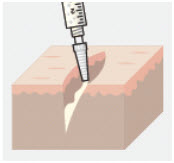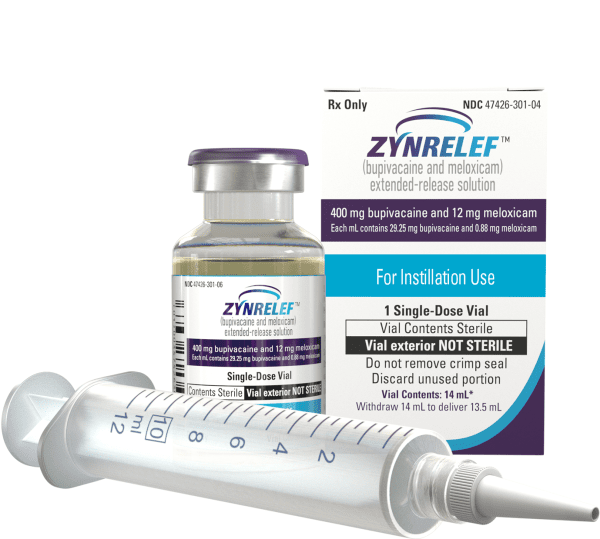Zynrelef Dosage
Generic name: BUPIVACAINE 400mg in 14mL, MELOXICAM 12mg in 14mL
Dosage form: solution
Drug class: Analgesic combinations
Medically reviewed by Drugs.com. Last updated on Dec 3, 2024.
Important Dosage and Administration Information
ADMINISTER ZYNRELEF VIA INSTILLATION ONLY.
- ZYNRELEF should not be administered via the following routes.
- –
- Epidural
- –
- Intrathecal
- –
- Intravascular
- –
- Intra-articular
- –
- Regional nerve blocks
- –
- Pre-incisional or pre-procedural locoregional anesthetic techniques.
- ZYNRELEF is intended for single-dose administration only.
- As there is a potential risk of severe, life-threatening adverse reactions associated with the administration of bupivacaine, ZYNRELEF should be administered in a setting where trained personnel and equipment are available to promptly treat patients who show evidence of neurologic or cardiac toxicity.
- The toxic effects of local anesthetics are additive. Avoid additional use of local anesthetics within 96 hours following administration of ZYNRELEF.
- Avoid intravascular administration of ZYNRELEF. Convulsions and cardiac arrest have occurred following accidental intravascular injection of bupivacaine and other amide-containing products.
- Limit exposure to articular cartilage due to the potential risk of chondrolysis.
- ZYNRELEF is a viscous solution supplied as a kit consisting of a single-dose glass vial, and the following sterile components: Luer lock syringe(s), a vented vial spike or vial access needle, Luer lock cone-shaped applicator(s), and syringe tip cap(s). ZYNRELEF should only be prepared and administered with the components provided in the ZYNRELEF kit. See the ZYNRELEF Instructions for Use included in the kit for complete administration instructions with illustrations.
- The contents of the ZYNRELEF vial are sterile. The vial exterior is not sterile. Follow your facility's standard operating procedures regarding aseptic drug preparation.
- Each ZYNRELEF vial contains overfill to compensate for residual amounts that remain in the vial, vented vial spike or vial access needle, Luer lock applicator, and syringe(s) during drug withdrawal and administration.
- ZYNRELEF is applied without a needle into the surgical site after placement of implant(s) (if applicable), following final irrigation and suctioning, and prior to suturing of each layer, when multiple tissue layers are involved.

- When ZYNRELEF comes in contact with moisture in the tissues, it becomes more viscous, allowing it to stay in place.
- ZYNRELEF does not degrade sutures. When tying knots with monofilament sutures, contact with ZYNRELEF may cause knots to loosen or untie due to the viscosity of ZYNRELEF. In vitro studies showed an increase in elasticity with monofilament sutures exposed to ZYNRELEF with unknown clinical significance. Minimize administration of ZYNRELEF near the incision line and wipe off excess ZYNRELEF from the skin prior to suturing. Three (3) or more knots ending in a multi-throw knot (e.g., a Surgeon's knot) are recommended with monofilament sutures. Braided or barbed sutures are recommended, especially for closure of deeper layers.
Preparation Instructions
See the ZYNRELEF Instructions for Use included in the kit for complete administration instructions with illustrations.
- ZYNRELEF is a clear, pale yellow to yellow, viscous liquid. Visually inspect the ZYNRELEF vial for particulate matter and discoloration. Obtain a new vial if particulate matter or discoloration is observed.
- Prepare vial for filling of syringe(s) by attaching vented vial spike or vial access needle.
- Syringe attachment for product withdrawal:
- For vented vial spike, fill syringe with air prior to attaching syringe. Attach syringe to vented vial spike, invert vial and syringe to allow product to fill the vial neck, then push air into vented vial spike prior to withdrawing ZYNRELEF from vial.
- For vial access needle, do not fill syringe with air prior to attaching syringe. Attach syringe to vial access needle, then invert vial and syringe to allow product to fill the vial neck prior to withdrawing ZYNRELEF from vial.
- Withdraw dose of ZYNRELEF into syringe. (The dose volume takes into account the potential residual volume in the components.). Withdrawal time using the vial access needle is faster than the vented vial spike.
Nominal Dose of Bupivacaine / Meloxicam Number of Syringes and LLAs* Per Dose Volume to be Withdrawn - *
- LLA: Luer lock cone-shaped applicator
60 mg/ 1.8 mg 1 2.3 mL (using 3 mL syringe provided) 200 mg / 6 mg 1 7 mL (using 12 mL syringe provided) 300 mg/ 9 mg 1 10.5 mL (using 12 mL syringe provided) 400 mg/ 12 mg 2 14 mL (using two 12 mL syringes provided, 7 mL ZYNRELEF per syringe) - Repeat steps 1-3 for more than one syringe.
- Prepare product immediately prior to use and apply syringe tip cap if needed until product delivery.
Administration Instructions
Before administration, remove the syringe tip cap and attach the Luer lock cone-shaped applicator to the syringe.
- Using the Luer lock cone-shaped applicator attached to the syringe, apply ZYNRELEF to the tissues within the surgical site as follows:
- For soft tissue procedures, apply ZYNRELEF into the wound prior to closure of each layer within the surgical space.
- –
- For abdominal procedures, apply after closure of the peritoneum (if applicable) and avoid administration below the peritoneum.
- In general for orthopedic procedures, apply ZYNRELEF into the wound and on the periosteum from the proximal to the distal ends of the wound (i.e., beyond the boney repair).
- –
- For total joint arthroplasty, apply ZYNRELEF directly into the joint capsule, onto the periosteum, and the antero-, medial-, and lateral tissues (if applicable), after placement of the component(s).
- –
- For spinal procedures, apply ZYNRELEF after closure of the paraspinal musculature and again after closure of the subcutaneous fascia. ZYNRELEF must not be applied to the dura or spinal cord.
- For soft tissue procedures, apply ZYNRELEF into the wound prior to closure of each layer within the surgical space.
- Only apply ZYNRELEF to the tissue layers below the skin incision and not directly onto the subdermal layer or the skin. Minimize administration of ZYNRELEF near the incision line.
- Use only the amount necessary to coat the tissues, such that ZYNRELEF does not leak from the surgical wound after closure. Wipe off excess ZYNRELEF from the skin prior to or during closure of the wound.
Dosing Instructions
As a general guidance in selecting the proper dosing of ZYNRELEF, the following examples of dosing are provided:
- For soft tissue surgical procedures, such as:
- –
- open inguinal herniorrhaphy: up to 10.5 mL to deliver 300 mg of bupivacaine and 9 mg of meloxicam;
- –
- abdominoplasty: up to 14 mL to deliver 400 mg of bupivacaine and 12 mg of meloxicam;
- –
- Cesarean section: up to 14 mL to deliver 400 mg of bupivacaine and 12 mg of meloxicam;
- –
- augmentation mammoplasty: up to 7 mL per side to deliver total of 400 mg of bupivacaine and 12 mg of meloxicam.
- For orthopedic surgical procedures, such as:
- –
- bunionectomy: up to 2.3 mL to deliver 60 mg of bupivacaine and 1.8 mg of meloxicam;
- –
- total knee arthroplasty: up to 14 mL to deliver 400 mg of bupivacaine and 12 mg of meloxicam;
- –
- total shoulder arthroplasty: up to 14 mL to deliver 400 mg of bupivacaine and 12 mg of meloxicam;
- –
- 1- to 3-level spinal surgery: up to 7 mL to deliver 200 mg bupivacaine and 6 mg meloxicam.
Compatibility Considerations
- Do not dilute ZYNRELEF.
- ZYNRELEF is a nonaqueous solution. It cannot be mixed with water, saline, or other local anesthetics as the product will become more viscous and difficult to administer.
- When a topical antiseptic such as povidone iodine (e.g., Betadine®) is applied, the site should be allowed to dry before a local anesthetic, including ZYNRELEF, is administered into the site.
- When administered in recommended doses and concentrations, ZYNRELEF does not ordinarily produce irritation or tissue damage.
ZYNRELEF is compatible with:
- All components of the ZYNRELEF kit, including syringes, Luer lock cone-shaped applicator, vented vial spike, vial access needle, and syringe tip caps.
- Surgical mesh materials, including polypropylene (Prolene®), Gore-tex, and polyester.
- Silicone membranes.
- Bone cement.
- Metal alloys used in surgical implants.
More about Zynrelef (bupivacaine / meloxicam)
- Check interactions
- Compare alternatives
- Pricing & coupons
- Reviews (1)
- Drug images
- Side effects
- During pregnancy
- FDA approval history
- Drug class: analgesic combinations
- En español
Patient resources
Professional resources
Related treatment guides
Further information
Always consult your healthcare provider to ensure the information displayed on this page applies to your personal circumstances.



